Printers for printing labels: features and tips for choosing
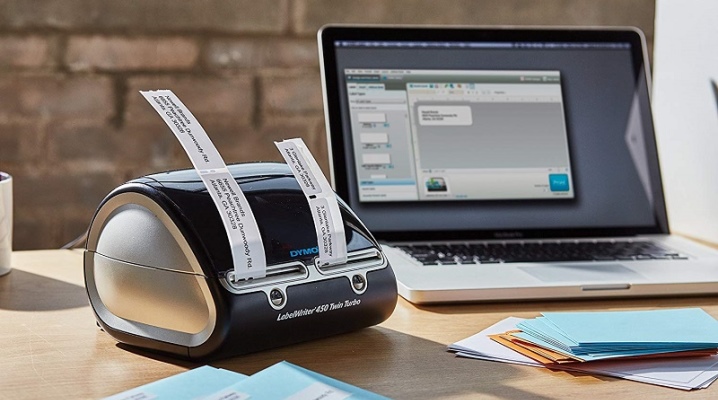
Modern conditions of the trading system require labeling of goods, therefore the label is the main element that contains all information about it, including the barcode, price, and other data. Labels can be printed by typographic method, but for marking different product groups it is more convenient to use a special device - a label printer.
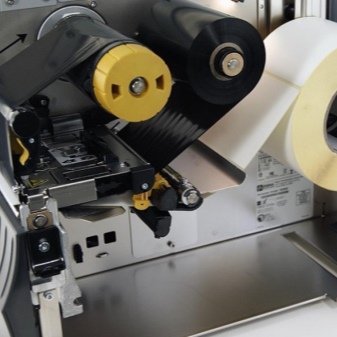
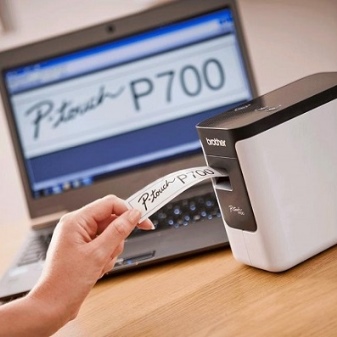
What is it and what is it for?
The printer for printing labels is used not only in the trade, but also for production needs, for printing cash receipts in the service sector, for the operation of warehouse terminals, in the field of logistics for labeling goods and so on. The printer is needed for thermal transfer of information onto small paper media. All goods that are subject to labeling must have a one-dimensional or 2D barcode format. Such marking allows you to keep track of goods or goods in specially designed software systems. If you order such labels for marking in a printing house, then it will take a certain amount of time to complete the order, and the cost of printing is not cheap.
A label printer can create a large print run, and the cost of the copies will be low. In addition, the machine has the ability to quickly adjust the original layout and print those labels that are needed at the moment. A distinctive feature of such units is the printing method. There are models that use thermal transfer printing, for which the device is equipped with an ink thermal tape. With the help of such a tape, it is possible not only to transfer data to a paper base, but also to print on polyester or fabric. In addition, there are a number of thermal printers that do not require additional ink ribbon, but only produce a black and white image printed on thermal paper.
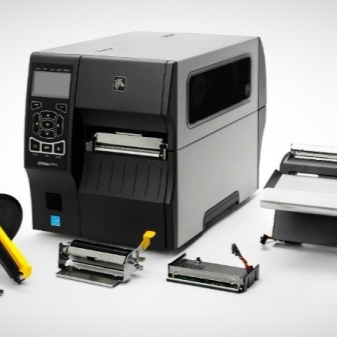
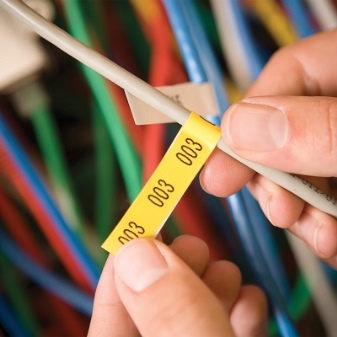
Printers are also subdivided according to the shelf life of the finished label. For example, for labeling food products, labels are used that retain an image for at least 6 months, such a label can be printed on any printer intended for this. For industrial use, labels with higher quality printing will be required, their shelf life is at least 1 year, and only special models of printers provide such quality labels.
Printer resolution and font size selection are important factors when printing labels. The standard resolution is 203 dpi, which is quite enough for printing not only text, but also small logos. If you require higher quality printing, you must use a printer with a resolution of 600 dpi. Another feature of printers is their productivity, that is, the number of labels they can print per work shift.
The performance of the printer is chosen depending on the scope of its application and the need for marking. For example, for a small private business, a device model that prints 1000 labels each is quite suitable.
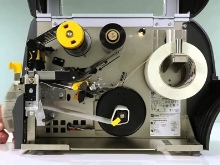
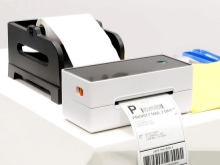

Species overview
Thermal printers that print different types of labels fall into 3 broad categories:
- office mini-printers - productivity up to 5000 labels;
- industrial printers - can carry out continuous round-the-clock printing of any volume;
- commercial devices - prints up to 20,000 labels.
Modern devices, such as a thermal transfer printer, can vary the intensity of the print by adjusting the temperature as well as the speed of the printing process. It is important to select the correct temperature setting, as low readings and high print speeds will produce faint labels.
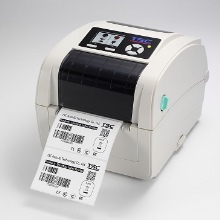
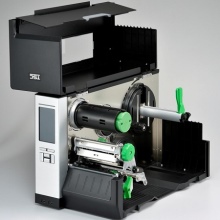
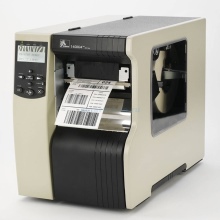
As for the dye-sublimation type of equipment, the principle of operation here is based on the application of a crystalline dye to the surface of the paper, and the printing intensity will depend on the amount of dye in the cartridge. The dye sublimation printer allows you to print a color barcode layout. A type of such a device is a thermal jet tape marker. There is also a simpler dot matrix printer, where self-adhesive labels (in rolls) are printed with an impact method of applying small dots that form an integral image.
The thermal printer for printing has a certain set of options, which are divided into general and additional ones necessary for professional use. A built-in USB port with network connectivity can complement the common base. Professional printers have options for connecting fiscal modules, and for some models, the manual principle of label cutting can be replaced with an automatic one (with a selected step of cutting roll labels).
Depending on the availability of additional options, the cost of printing equipment also changes. Printers used to create marking labels are also distinguished by other criteria.
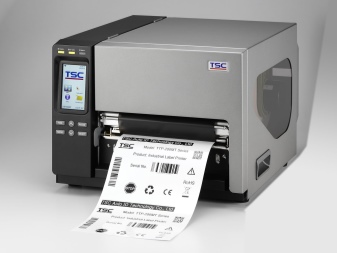
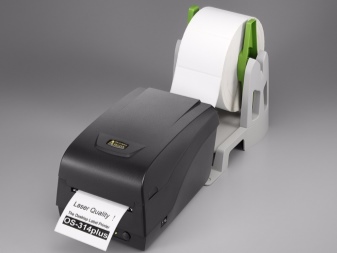
By area of use
The scope of application of printing devices is different, and, based on the tasks assigned to the device, it has different dimensions and operating parameters.
- Mobile stand-alone printer. Used to create small size bar-coded labels. This device can be moved around a warehouse or trading floor, power is supplied using a rechargeable battery. The device connects to a computer via a USB port, and also communicates with it via Wi-Fi. The interface of such devices is simple and straightforward for the user. The printer is resistant to damage and is compact. The principle of operation is the use of thermal printing with a resolution of 203 dpi. Every day, such a device can print 2000 pieces. labels, the width of which can be up to 108 mm. The device does not have a cutter and label dispenser.
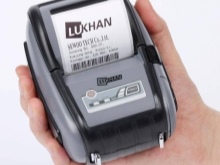
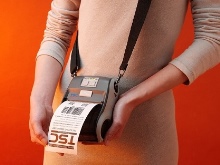
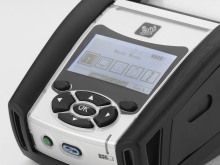
- Desktop type printer. It is used stationary, on the operator's desktop. The device connects to the computer via the USB port. Can be used in small scale offices or retail outlets. The device has additional options for an external tape rewinder, cutter and label dispenser. Its performance is slightly higher than that of its mobile counterpart. The image on the label is applied by thermal transfer or thermal printing is used. You can select the degree of print resolution from 203 dpi to 406 dpi. Belt width - 108 mm. Such devices print 6,000 labels per day.
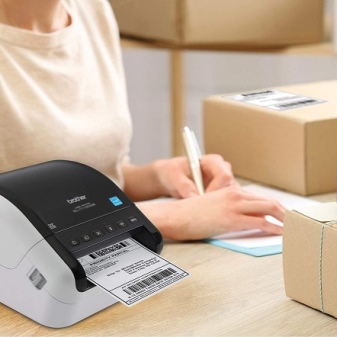
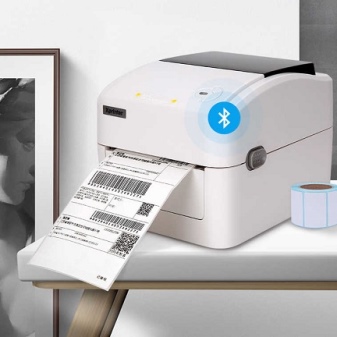
- Industrial version. These printers have the fastest print speeds and are capable of continuous operation, producing tens of thousands of high quality labels. An industrial printer is necessary for large trade enterprises, logistics, warehouse complex. The print resolution can be selected from 203 dpi to 600 dpi, the width of the tape can be up to 168 mm. The device can have a built-in or separately attached module for cutting and separating labels from the backing. This device can print linear and 2D bar codes, any logos and fonts, including graphics.
The demand for all three types of printing printers at the present time is quite high. Models are constantly being improved by the variety of their optional capabilities.
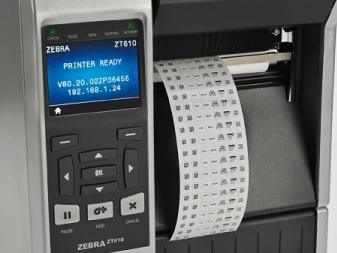
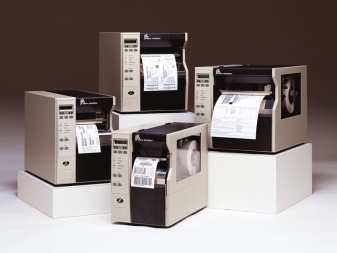
By printing method
A label printer can do its job on thermal paper, but it also works on fabric. By the method of printing, the devices are divided into two types.
- Thermal transfer view. For work, it uses a special ink ribbon called a ribbon. It is placed between the label substrate and the print head.
- Thermal view. It prints with a thermal head directly on thermal paper, on which one of the sides is covered with a heat-sensitive layer.
Both types of printing are based on the use of heat. However, such a print is short-lived, as it loses its brightness under the influence of ultraviolet radiation and humidity. It is noteworthy that labels made on thermal transfer paper are more durable, and, unlike thermal labels, they can be printed in color on film, fabric and other media. This quality is explained by the use of ribbons, which are a tape impregnated with a wax-resin composition. Ribbons can be of different colors: green, red, black, blue and gold.
Devices that use the thermal transfer method are versatile because they can print in the usual way on thermal tape, which saves on consumables.

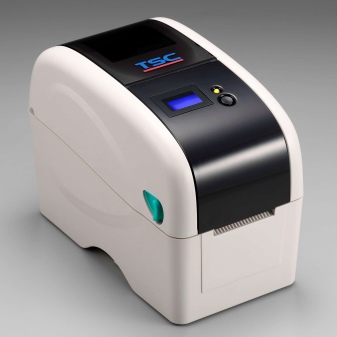
Main characteristics
Label machines have certain general characteristics.
- Resource of the press - is determined by the maximum number of labels that can be printed within 24 hours. If, when there is a great demand for labels, a device with a low productivity is used, then the equipment will work for wear and will quickly exhaust its resources.
- Belt width - when choosing a printing device, you need to know how much and what information will need to be placed on the labels. The choice of the width of the thermal tape stickers also depends on the definition of needs.
- Print resolution - a parameter that determines the brightness and quality of the print, it is measured in the number of dots located on 1 inch. For store and warehouse markings, a print resolution of 203 dpi is used, printing a QR code or logo will require a resolution of 300 dpi, and the highest quality printing option is performed at a resolution of 600 dpi.
- Label cut option - can be a built-in device, it is used when products are marked immediately after printing a label.
Modern printing equipment also has additional options that improve the work process, but also affect the cost of the device.

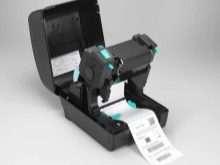
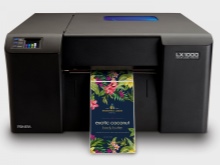
Top Models
Equipment for printing labels today is produced in a wide range, and you can choose any type of device that meets the criteria for the task, you should also take into account the dimensions of the device.
- EPSON LABELWORKS LW-400 model. Compact version that weighs about 400 grams. The control buttons are compact, there is an option to quickly activate printing and paper cutting. The device can store at least 50 different layouts in the memory. The tape is visible through the transparent window, which makes it possible to control its remainder. It is possible to select a frame for the text and customize the writing fonts. There is an option to narrow the margins to save tape and print more labels. The screen is backlit, which makes it possible to work in any degree of illumination. The disadvantage is the high cost of consumables.
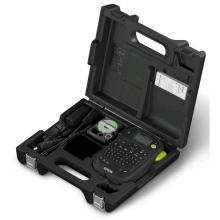

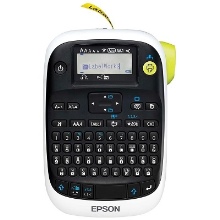
- Model BROVER PT P-700. The device with small dimensions allows you to work in cramped conditions. Power is supplied through a computer that supports Windows programs, so layouts can be prepared not on a printer, but on a PC. The width of the label is 24 mm, and the length can be from 2.5 to 10 cm, the printing speed is 30 mm of tape per second. The label layout can contain a frame, logo, text content. It is possible to change the type of fonts and their color. The disadvantage is a large waste of electricity.
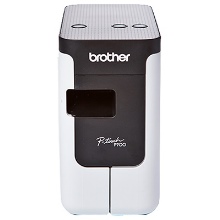
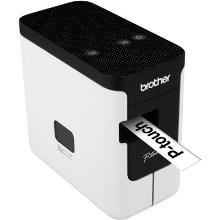
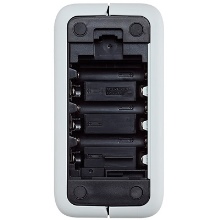
- Model DYMO LABEL WRITER-450. The printer is connected to a PC via a USB port, the layout is created using software that can process data in Word, Excel and other formats. Printing is carried out with any fonts with a resolution of 600x300 dpi. Up to 50 labels can be printed every minute. Templates can be stored in a specially created database. Printing can be performed in vertical and mirror positions, there is an automatic cut of the tape. It is used not only for trade labels, but also for marking tags for folders or discs. The disadvantage is the low speed of label printing.
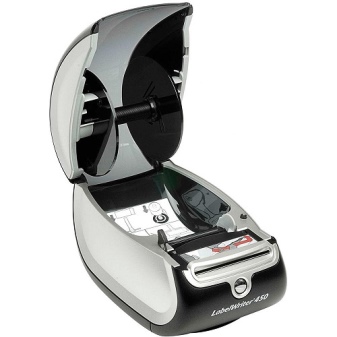

- Model ZEBRA ZT-420. It is a stationary office equipment that has several connection channels: USB port, Bluetooth. When setting up, you can choose not only the print quality, but also the size of labels, including small format. In 1 second, the printer is capable of printing more than 300 mm of ribbon, the width of which can be 168 mm. The machine allows you to open Web pages and use the information for labels from there. The paper and ribbon tray is illuminated. The disadvantage is the high cost of the printer.

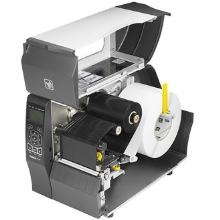
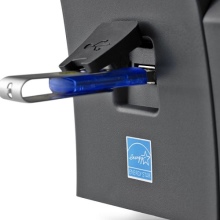
- DATAMAX M-4210 MARK II model. The office version, which is equipped with a 32-bit processor and a high quality Intell print head. The body of the printer is made of metal with an anti-corrosion coating. The device has a wide backlit screen for control. Printing is carried out with a resolution of 200 dpi. There are tape trimming options, as well as USB, Wi-Fi and Internet connections, which greatly facilitates its collaboration with a PC. This printer can print up to 15,000 labels per shift. The device has a large amount of memory for saving layouts. The disadvantages are the heavy weight of the device.
The cost of a label printer depends on its functionality and performance.



Expendable materials
For thermal printing, only a paper base covered with a heat-sensitive layer is used as an information carrier. If the equipment works by means of the thermal transfer method, then it is able to print a label or tag to the product not only on paper, but also on a textile tape, it can be thermal film, polyethylene, polyamide, nylon, polyester, etc. the material used is a ribbon - ribbon. If the tape is impregnated with a composition with wax, then it is used for paper labels, if the impregnation has a resin base, then printing can be performed on synthetic materials. Ribbon can be impregnated with wax and resin, such a tape is used for printing on thick cardboard, while the image will be bright and durable.
Ribbon consumption depends on how it is wound on the roller, as well as on the width of the label and the density of its filling. In devices of the thermal transfer type, not only the ink ribbon is consumed, but also the ribbon for the labels on which the printing is performed. The ribbon sleeve can be up to 110mm long, so you don't need to buy a ribbon that will cover the entire sleeve to print narrow labels. The width of the ribbon is ordered in accordance with the width of the label, and it is fixed in the center of the sleeve. The ribbon has only one ink side, and the ribbon is wound with the print side inside the roll or outside - the type of winding depends on the design features of the printer.
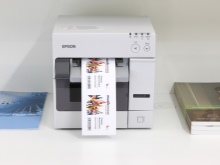
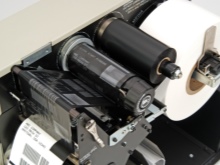
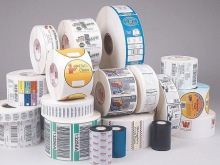
Secrets of choice
The label printer is chosen based on the conditions of its use and the volume of productivity. If you need to transfer your device, you can choose a portable wireless machine that will print a limited number of small adhesive labels. The stationary labeling printer weighing 12-15 kg is chosen for printing large quantities of labels.
When choosing a printer, you should consider important nuances.
- How many labels are required to be printed in one work shift.For example, a large store or warehouse complex would require the purchase of class 1 or class 2 devices that print several thousand stickers daily.
- Sizes of labels. In this case, you need to determine the width of the tape so that all the necessary information can fit on the sticker. Small marker labels or receipts are 57 mm wide, and if needed, you can use a printer that prints on 204 mm tape.
- Depending on the method of applying the image, a printer is also selected. A cheaper option is a device with conventional thermal tape printing, while expensive thermal transfer machines can print on other materials. The choice of printing method depends on the desired shelf life of the label or receipt. For a thermal printer, this period does not exceed 6 months, and for a thermal transfer version - 12 months.
Having decided on the model of the printing device, it is necessary to conduct a test test and see what the marking sticker will look like.

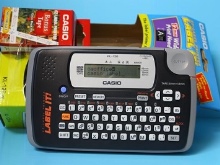

User manual
Setting up the operation of a printing device is similar to a conventional printer connected to a computer. The algorithm of actions here is as follows:
- the printer must be installed at the workplace, connected to the power supply and the computer, and then set up the software;
- further work is done to create a label layout;
- the software indicates the source of the print: from a graphic editor or from a product accounting program (depending on where the layout is made);
- a print medium is installed in the printer - thermal tape for thermal printing or other;
- Before printing, a calibration is performed to select options for format, print speed, resolution, color, and more.
After completing these preparatory work, you can begin the label printing process.
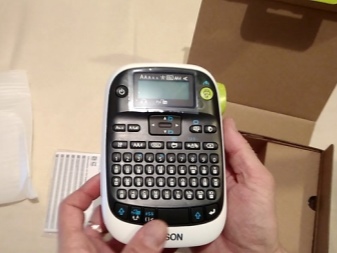
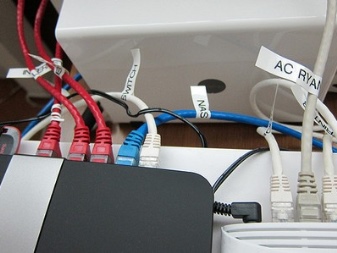
The complexity of working with a thermal printer can be the process of creating a label layout, which is performed in a graphic editor. To use such an editor, you need to have certain skills. The editor is similar to the Paint editor, where you can select the language, font type, slant, size, add a barcode or QR code. All elements of the layout can be moved around the working area using a computer mouse.
It is worth remembering that only certain languages †‹вЂ‹ are included in the printer software for recognition, and if the device does not understand the character you entered, it will appear on the print as a question mark.
If a logo or symbol needs to be added to the layout, it is copied from the Internet or other graphic layout by inserting it into the label field.















Very informative article! I wish you success!
The comment was sent successfully.